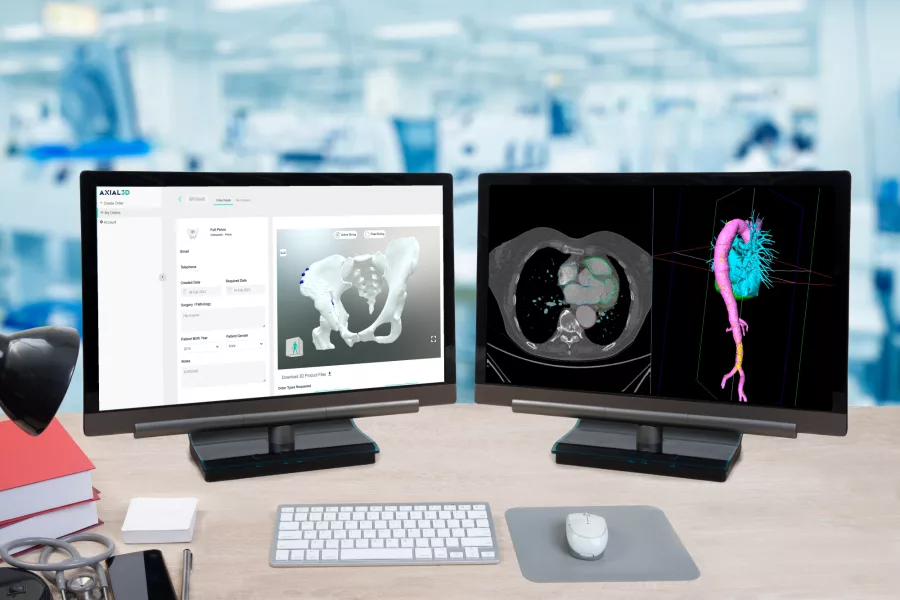Key Considerations for Selecting a Segmentation and 3D Solution for Medical Device Companies
Medical image segmentation—the process of delineating anatomical structures or regions of interest within medical images—is notoriously time-consuming and labor-intensive. Historically, this process requires extensive manual input from trained radiologists, which can lead to expensive outsourcing with a third-party vendor or an in-house backlog of cases for applications like pre-surgical planning, medical device sizing, patient-specific device planning, and post-market surveillance.
In recent years, AI-driven machine learning algorithms have automated and accelerated segmentation tasks with unprecedented speed and accuracy—which offers significant advantages when it comes to building a patient specific device program at scale. To overcome some of the challenges inherent to segmenting anatomy from DICOM medical images, these AI-powered tools recognize complex patterns and features within images, allowing them to segment anatomical structures with minimal hands-on intervention.
AI-Assisted segmentation not only reduces the workload for in-house planners and vendor teams, but it also produces accurate, consistent 3D data.. And as AI continues to evolve, it holds the potential to further streamline medical device workflows and truly operationalize personalized medicine at scale for the first time.
Selecting the right medical image segmentation solution is crucial for leveraging these advancements effectively. Here are a few considerations for choosing the right solution.
1. Accuracy
Pain point: Even the smallest errors in the process of mapping and measuring anatomical structures can have huge consequences on device fit, product performance, and ultimately, case outcomes.
What to consider: Ensure that the segmentation and 3D solution you select uses an algorithm that has been validated and tested against clinical benchmarks. This will give you peace of mind about the reliability of the analysis.
2. Accessibility
Pain point: In a validated quality management system, new solutions are often deployed in ways that disrupt existing workflows and add manual tasks for engineers, product managers, case planners, and sales reps. This disconnection can hinder efficiency and create unnecessary complexity.
What to consider: To effectively implement a new tool, it should seamlessly integrate with your current workflows, allowing for smooth data sharing across platforms and ensuring interoperability. Ease of use is equally crucial. Many segmentation software solutions require bulky hardware and powerful laptops, making them impractical for sales reps or clinical specialists who need flexibility. Opt for cloud-based solutions with intuitive user interfaces that provide easy access from any location or device, eliminating the need for cumbersome hardware and making it simpler to manage cases on the go.
3. Customization and Flexibility
Pain point: No two devices and workflows are exactly alike—and a one-size-fits-all solution fits no one.
What to consider: Every device manufacturer knows that the systems and processes you work within are unique to your R&D, manufacturing, and quality management system for your device. A customizable solution can actually allow you to close gaps in your existing process without dismantling validated workflows. A customizable solution gives you the flexibility to adapt the technology to your specific requirements—not the other way around.
4. Cost
Pain point: Securing buy-in for the upfront investment required for a traditional, on-site software license can be challenging.
What to consider: While cost is a significant factor when it comes to decision making, it’s important to consider the overall value the solution provides rather than just the upfront price. Assess the cost in relation to the benefits offered, such as improved patient outcomes, efficiency gains, and long-term savings.
Additionally, factor in the costs associated with scaling the solution, including the training and salaries of employees required to effectively implement and maintain the system, as well as any additional resources needed for integration. A comprehensive cost-benefit analysis should encompass these elements to provide a clear picture of the total investment. This approach will help you make an informed decision that aligns with your budget and goals, ensuring that you achieve the best possible return on investment.
5. Scalability
Pain point: Hiring and retaining large teams of engineers for segmentation tasks is challenging due to high fixed costs and lengthy training and onboarding processes. This rigidity can make it difficult to plan for and meet the demands of a new product as it scales in the market.
What to consider: Technology evolves rapidly, so it’s crucial to choose a solution that can scale with your growing needs and adapt to future advancements. Look for a SaaS-based offering that provides modularity, automation, and the flexibility to incorporate new features and updates. AI and machine learning capabilities are essential for scalability, allowing systems to learn and improve over time, handle increasing data volumes, and provide more sophisticated analyses. This approach enables you to do more with fewer resources, minimizing upfront capital expenditure and reducing the need for extensive staffing. Evaluating how your resources are affected by growth ensures your investment stays relevant and valuable, effectively future-proofing your operations.
The Bottom Line
Selecting the right segmentation and 3D solution is a critical decision for medical device companies. This choice directly impacts whether or not you can deliver personalized medicine at scale.
Are you ready to explore a different way to segment your data? At Axial3D, our platform offers robust scalability for your custom and patient-matched devices, utilizing patented technology powered by advanced machine learning algorithms and AI-enabled automation. Learn more.
Let's talk.




